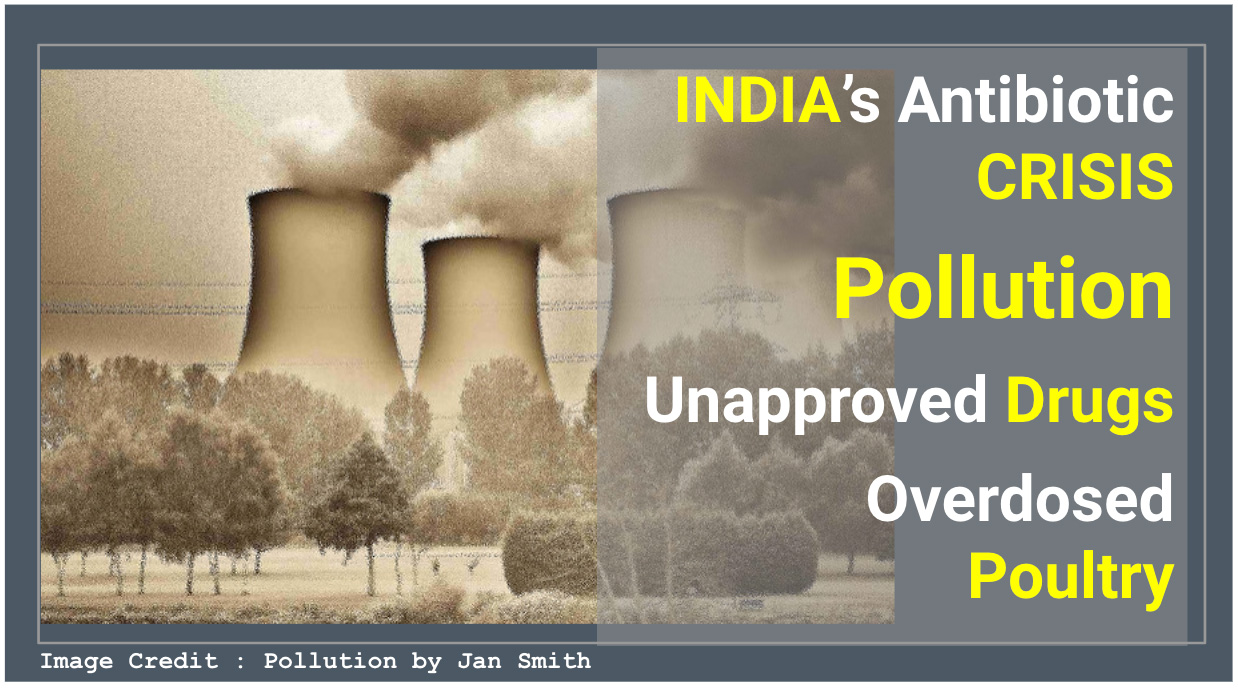
In June 2015, PharmaCompass reported on antibiotic contamination in rivers in China, which wasn’t a result of the factories that produce antibiotics. The issue had opened another battlefront for the global war on superbugs, or bacteria that grow resistant to drugs.
China, the largest producer and user of antibiotics in the world, has also been in news for using colistin — a last resort antibiotic — in agriculture, to speed growth of animals raised for meat.
But the problem has spread much beyond China.
India has one of the highest rates of antibiotic consumption and antimicrobial resistance. In 2016, India consumed more than 2.6 billion packs or US$ 2.3 billion (INR 150 billion) worth of antibiotics, a statistic that puts it among the world’s largest consumers of antibiotics.
Last week, three news reports — based on actual studies conducted in India — highlight the fact that the problem is grave. They point to the fact that multinational drug companies are continuing to produce and sell unregulated antibiotics in India; that chickens reared in India are being given colistin, the strongest antibiotic, to promote growth; and that pharma companies are irresponsibly disposing off heavy metals and industrial solvents, posing serious threat to health.
These reports reveal that both drug companies and their consumers in India are behaving irresponsibly, and aren’t giving much thought to the growing menace of antimicrobial resistance.
Strongest
antibiotics administered on chickens
A study by the Bureau of Investigative Journalism revealed that chickens raised in India for food have been dosed with colistin, an ‘antibiotic of last resort’.
Hundreds of tonnes of colistin are shipped to India each year. The drug is being given to chickens and other farm animals to make them gain weight faster and as pre-emptive protection against diseases. But the antibiotic is also used as a last line of defense in humans whose infections are not responding to other drugs.
The report found 2,800 tonnes of colistin were shipped to developing countries including India, Vietnam, Russia, Mexico, Colombia and Bolivia for use on animals in 2016. The bureau said the total was likely to be higher as the product could be delivered under a different name, and to countries which do not make their customs data public.
The consequences of the use of colistin on animals will be “felt throughout the world because resistance to strong antibiotics is spread among organisms,” a report published in The Guardian said. With increasing resistance to drugs, diseases that were commonly treatable in the last century will become deadly once again.
Studies in China have revealed that a wide variety of E. coli bacteria have developed resistance to colistin, The gene known as mcr-1—which has the capacity to move from one bacterium to another— was found in about 1 percent of E. coli bacteria and 1 percent of a bacteria, known as Klebsiella pneumoniae, that can cause pneumonia, bloodstream infections, and wound infections.
There is nothing to prevent Indian farmers, which include some of the world’s biggest food producers, from exporting their chickens and other related products to countries across the world.
Production and
sale of unregulated antibiotics
The second indicator to the worsening menace of antibiotic resistance in India came from a study undertaken in the UK. It said multinational companies continue to produce and sell unregulated antibiotics in India.
The report released this week by researchers at Queen Mary University of London and Newcastle University, said millions of antibiotic pills being sold in the Indian market have not been regulated in India, the UK or US. The research was published in the British Journal of Clinical Pharmacology.
Out of 118 different formulations of fixed dose combination (FDC) antibiotics sold in India between 2007 and 2012, 64 percent were not approved by the Central Drugs Standard Control Organization (or CDSCO, the regulatory body for Indian pharmaceuticals and medical devices), even though sale or supply of unapproved new medicines in India is illegal. FDCs are formulations composed of two or more drugs in a single pill.
In fact, many of the unapproved FDCs combine poorly chosen antimicrobials that can worsen resistance problems. The FDC antibiotics were sold under more than 3,300 brand names made by almost 500 drug makers, of which 12 were MNCs. The report said Abbott, Astra Zeneca, Baxter, Bayer, Eli Lilly, GlaxoSmith-Kline, Merck/MSD, Novartis, Pfizer, Sanofi-Aventis, and Wyeth, manufactured 45 percent (53) of the 188 FDCs under 148 brand names.
Only 4 percent of the FDCs were approved in the US or UK.
Drug
companies polluting environment
A Swedish financial services group — Nordea — released a report that raised doubts whether even the well-known pharmaceutical companies operating in Hyderabad were following pollution control measures. The Nordea report comes at a time when India’s environment ministry is sitting on a proposal to clear the Hyderabad Pharma City project, proposed over 19,633 acres of land.
An NGO — Changing Markets Foundation — was commissioned by Nordea to study the polluted water accumulated adjacent to manufacturing units and seeping from them. The units were of the pharmaceutical companies Mylan, Dr Reddy’s Laboratories and three others. Samples were also collected from the back side of hazardous waste disposal facility at Gaddapotharam, run by Ramky Enviro Engineers.
The NGO found the “occurrence of a range of heavy metals and industrial solvents commonly used in pharmaceutical manufacturing. In some cases, these were found to be present at extremely high concentrations, orders of magnitude higher than maximum regulatory limits or safe exposure…posing serious threat to health.”
“The mere presence of some of these substances is cause for alarm given their extreme toxicity. In addition, the occurrence of mixtures of chemicals shows a lack of adequate treatment prior to discharge,” the report said.
Hexavalent chromium denoted as Cr(VI), a known carcinogen, was found in most of the collected samples. In groundwater sample from Gaddapotharam, Cr(VI) concentration was an alarming 10,900 micrograms/liter against the maximum permissible limit by BIS of 50 microgram/litre.
Spokespersons of Dr Reddy’s Laboratories and Mylan, however, rejected the report as false.
An earlier report by Changing Markets – titled ‘Superbugs in the Supply Chain - How pollution from antibiotics factories in India and China is fueling the global rise of drug-resistant infections’ had revealed the presence of drug-resistant bacteria at pharmaceutical manufacturing sites in India.
On-the-ground research and analysis of water samples had found high levels of drug-resistant bacteria at sites in three Indian cities: Hyderabad, New Delhi and Chennai. Out of 34 sites tested, 16 had been found to be harboring bacteria resistant to antibiotics.
At four of the sites, resistance to three major classes of antibiotics was detected, including antibiotics of ‘last resort’, those used to treat infections that fail to respond to all other medicines.
The report had cited Hyderabad-based Aurobindo Pharma as one of the worst offenders. However, Pharmaceuticals Export Promotion Council of India (Pharmexcil), which is part of India’s ministry of commerce, had termed the report as “fabricated” and “backed by vested interests” to malign the Indian pharma industry—the world’s largest producer of antibiotics.
Our view
Antibiotics first came into use after the somewhat serendipitous event on September 3, 1928 that led to the discovery of penicillin by Alexander Fleming. Since then, many of the bacteria these drugs are designed to target have developed antibiotic resistance. The Centers for Disease Control and Prevention (CDC) notes that there are 2 million antibiotic-resistant infections resulting in 23,000 deaths in the United States each year due to these superbugs.
Antibiotic resistance is a global healthcare challenge. It is said to overtake cancer in number of deaths by 2050 and cost the world economy almost US$ 100 trillion.
Ninety percent of the 10 million deaths caused by antibiotic resistance are expected to occur in Asia and Africa. In comparison, deaths due to cancer are estimated to be 8.3 million, diabetes 1.5 million, diarrhea 1.4 million and road accidents 1.2 million.
China has pledged to step up R&D into new antimicrobials and to curb overuse of existing medicines to counter growing global antimicrobial resistance through a national action plan unveiled in August 2016. India needs to vigorously follow suit.
According to a report published in The Economist, the cost of banning antibiotics as growth enhancers in farm animals is not great. A study undertaken by the US government suggests it might reduce the bottom line of those who currently use them by less than 1 percent. The European Union has already enacted such a ban.
India has taken strong action against smoking in public places to reduce passive smoking. In a similar way, it needs to come up with strict laws to fight the menace of antibiotic resistance.
The PharmaCompass Newsletter – Sign Up, Stay Ahead
Feedback, help us to improve. Click here
Image Credit : Pollution by Jan Smith is licensed under CC BY 2.0
“ The article is based on the information available in public and which the author believes to be true. The author is not disseminating any information, which the author believes or knows, is confidential or in conflict with the privacy of any person. The views expressed or information supplied through this article is mere opinion and observation of the author. The author does not intend to defame, insult or, cause loss or damage to anyone, in any manner, through this article.”






